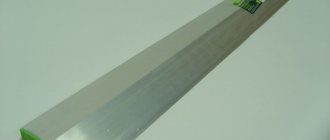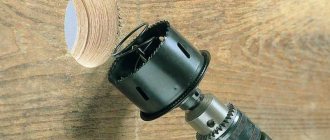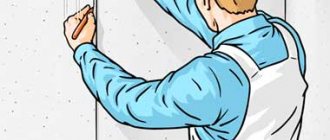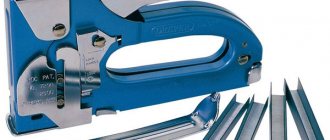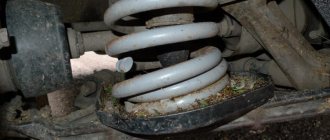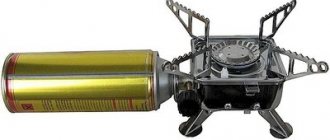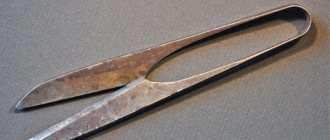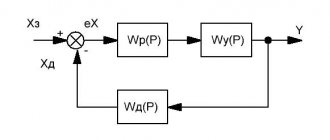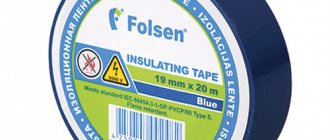The building rule is a tool for construction work, most applicable to plastering work. Without it, making a flat wall becomes much more difficult. It is easy to use, and the results are not much different from those obtained by professionals. How to choose a rule, photos with illustrations, nuances of use - further in the article.
Why do we need a rule?
The process of leveling and finishing walls with building mixtures seems quite simple when you observe the work of a professional from the outside. The prepared composition is thrown onto the wall and leveled so that at the end of the process the surface appears perfectly flat and smooth, without dents or bulges. The quality of work is checked using the same rule. They apply it to the wall and see if there are any gaps left between the treated surface and the working edge.
Interesting! According to a legend that has come down to us from the dashing nineties, the customer, checking the quality of finishing work, inserted large bills into the gaps found and counted their quantity. At the end of the “test” the amount received was deducted from the swindler’s salary.
Despite its simplicity, the device is a very functional device. It can be used to perform the following operations:
- leveling construction mixtures applied to the surface being treated;
- checking the plane of the wall;
- marking the surface to be leveled;
- the use of a perfectly flat surface of the body on which the building level is installed.
The main function remains leveling the construction mixture over the surface being treated. For this purpose, it has a perfectly flat working surface. By pressing it against the wall or floor and grabbing the solution, pulling it along the plane, the master levels the plane of the wall or floor. In this case, the holes and depressions are filled with a plastic composition. Excess solution is cut off with a sharp edge.
After the solution has hardened, the treated surface is ready for finishing:
- high quality painting;
- tile or wallpaper sticker;
- sticking linoleum or laying laminate (parquet boards).
Today, not only professional finishers, but also homeowners who carry out home renovations with their own hands have in their arsenal a set of slats of various lengths and profiles.
What is this
By its design, it is a rigid metal or wooden strip up to 3 m long with a sharp edge.
As a rule, the applied layer of plaster is leveled, excess mortar is removed, and the correct installation of the beacons and the flatness of the surface are checked. This tool can be used as a ruler when marking walls. It allows you to determine differences and deviations from the level and perform high-quality plastering of the surface for subsequent putty.
What are the rules?
There are four main types. Each of them has its own profile and specific purpose:
- h-shaped profile;
- trapezoid or wedge;
- rectangle;
- corner.
All of the listed varieties deserve a more detailed consideration.
h-profile
The most budget option. Very light. It is characterized by low rigidity and cannot withstand heavy loads. Designed for work with light plaster and putty mixtures. Its distinctive h-shaped profile replaces the handle and provides a comfortable grip. Light weight allows you to work for a long time and without fatigue. The sharp working edge perfectly levels the mixture and cuts off excess mortar, leaving a smooth surface without depressions or bumps after passing.
Trapezoid
This shape is often called a wedge. A universal option. The fairly rigid design makes it easy to use it to level heavy cement-based plaster mixtures, and the sharp wedge perfectly cuts off excess mortar.
The body is reinforced with a stiffening rib made in the form of a semicircle. In addition to rigidity, it provides a comfortable grip, creating additional support for the fingers. The trapezoid weighs more than the H-shaped models. Masters working with it need to have strong hands.
Rectangular rule
In appearance it looks a lot like a building level. Often, the manufacturer installs flasks with air bubbles into its design. In this case, the master has a device that combines both a rule and a level. The structure is very rigid and can withstand heavy loads. Its main purpose is to level heavy mortars when installing floor screeds.
For work on leveling walls, such a device is of little use, since it is not equipped with a sharp edge.
On a note! There are brick walls built so unevenly that they can only be leveled with a large layer of plaster along the installed beacons. In this case, rectangular profiles can be used.
With it, it will not be possible to cut off excess mortar and determine the curvature of the walls by applying it to the surface of the structure.
Angular rule
Aligning corners is not easy. The corner looks great, strictly vertical and straight, like an arrow. An angle with vertical deviations, which is a winding line, looks disgusting.
The presence of a corner device in the master’s arsenal allows you to align the junction of two adjacent walls, a wall and a ceiling, a wall and a floor. This is a professional option that has its own characteristics. Of course, you can use it as a right angle template, but this will not be entirely convenient, since such a device has significant weight.
The rule is a tool for plastering and more
Let's first compare two versions of this instrument; as we have already said, the rule can be either wooden or metal. But what distinguishes these two types? In theory, these tools are completely identical, even slats, what can I say. But if you use a wooden rule for plaster , then you can say with confidence that in a day it will be impossible to use it.
Everyone knows that plaster is prepared with water. Accordingly, the wood absorbs moisture, and after drying, the wooden guide simply loses its shape, and the smooth edges can become arched. The same cannot be said about tools made of metal; aluminum is mainly used. A tool in this design is, first of all, lightweight and convenient, which is a positive indicator during work. Changing the shape and its failure is excluded, unless, of course, this causes mechanical damage.
How to choose a rule
We already know for what work to use this or that profile. All that remains is to get acquainted with the remaining characteristics of this type of device, determine the selection criteria, or, more simply, what to look for when choosing a product.
Size
We are interested in the length. Typically, slats have dimensions of 1.0 length; 1.5; 2.0 and 2.5 meters.
There are 3-meter slats. This is a very special device. Two finishers work with it at once on large volumes of surface leveling. For work under normal conditions, a one and a half to two meter option is sufficient. It is better to have a set of 1.0 and 1.5 or 1.0 and 2.0 meter devices.
Edge quality
This criterion does not apply when choosing a rectangular profile. This most affects the choice of h-shaped profile. If, upon careful inspection of the edge, cavities and irregularities are discovered, the product is returned to the seller and the search continues.
On a note! High-quality aluminum, upon careful examination, has a yellowish tint and a characteristic aluminum sheen. The absence of these color effects tells the buyer that it is made from low-grade material.
If a device is chosen for professional activities, experts advise paying attention to a double-grip trapezoid with a steel working edge. Such a tool has a working life that significantly exceeds the durability of a conventional aluminum profile.
Rigidity
This criterion is used when assessing the quality of trapezoidal and rectangular models. Trapezoids have at least one semicircular longitudinal groove on the body. It provides additional support for the master’s fingers and gives the product additional rigidity. An additional stiffening rib of a semicircular cross-section can be located inside the trapezoid. Its presence allows you to level heavy cement mortars and light concrete when installing floor screed.
Important! Some rules are equipped with two stiffening grooves. Such models work with the heaviest solutions without undergoing deformation.
Two-grip
The working name of the trapezoidal rule with a semicircular stiffener. This semicircle along the entire product, in addition to imparting rigidity to the rail, contributes to a more comfortable grip with two hands, acting as a support for the master’s fingers.
This can be called rectangular profiles equipped with special holes for fingers. Trapezoidal two-wools have two semicircular grooves on opposite sides of the product. They are more convenient to use and have increased rigidity.
Features of the h-shape rule
This type of building rule is considered the simplest. In addition, products of this type are characterized by minimal weight. To achieve this effect, a thin-sheet aluminum alloy with a minimum number of ribs was used to provide additional rigidity.
Low weight is considered an advantage, but at the same time a disadvantage. The positive qualities of such a tool are considered to be convenience when performing installation work, and the disadvantages are the limited capabilities of the model.
The special design makes the tool easier to use. The metal protrusion is used as a handle. It is chosen for plastering the plane of walls. To perform a concrete floor screed, you should not choose such a product.
The best manufacturers
A good tool is made by the best manufacturers. Let's get to know some of them.
Matrix
Trademark of the German company Matrize Handels GmbH. Its product range includes at least 3,000 models. Among them are tools used in construction and repair:
- locksmith;
- carpentry;
- measuring;
- car repair kits;
- cutting tools for various purposes and designs;
- various fasteners.
As for the company’s construction finishing products, professionals pay tribute to its brushes, rollers, brushes, spatulas, trowels, trowels and, of course, rules of various profiles. Popular models of trapezoidal two-pieces are in high demand among experts.
JET
The American tool company JET Equipment & Tools was founded in 1958 in Seattle. The company became famous for its wood/metalworking equipment and even took a leading position in the United States in this market. Hand tools are not her main focus. Nevertheless, the popularity of JET models among professionals is high, and their quality matches the manufacturer’s reputation.
FIT
A trademark of the Canadian company of the same name, Finch Industrial Tools Canada Inc. The main direction of its activity is the production of hand-held power tools. We also produce hand tools for finishing work, including construction rules of various profiles and sizes. FIT is a quality product at a reasonable cost.
Bartex
Manufacturer from China. It has been on the market for quite a long time and has managed to gain popularity among buyers. The assortment includes many items for plumbing, carpentry and finishing purposes. All products are manufactured by large Chinese companies. The quality is at the level of world standards, the prices are budget.
Kraton
One of the domestic manufacturers of equipment and various equipment. For 18 years, the company has been pleasing its consumers with high-quality products and a wide range. Its abrasive wheels, compressor units, etc. are especially valued by professionals. The construction range includes everything needed for professionals, including spatulas, trowels and rules. All products are of high quality.
Bison
Russian manufacturer of professional tools. On the market since 2002. Today it is one of the leading domestic companies in this business. Zubr products are in demand among professionals and do-it-yourselfers. All products undergo serious quality control and meet the requirements of GOST and international standards. All models are issued with a warranty card valid for five years.
Biber
Manufacturer from Germany. Formed in 1950. The buyer knows this brand for its cleaning and care products for textiles, and products for making household work easier, including for apartment renovation. The European consumer appreciated the quality of its spatulas, rollers, brushes, paint containers and building regulations. Production facilities are located in Europe and China.
Stayer
The owner of the trademark is the German manufacturer – Kraftool. Our compatriots became acquainted with its products in 1999. The instrument with the Stayer brand was distinguished by its high quality and stylish design. Product production is deployed on modern equipment of factories in Germany and the Czech Republic, China, Taiwan and Malaysia. The manufacturer has developed four main lines of tools:
- for domestic use, models marked Standard are produced;
- home craftsmen are intended for products marked Master on the body;
- professional instruments are sold marked Profi;
- universal models, marked Universal.
The company annually develops new models, uses modern technologies, materials and innovations.
Our tool
The brand belongs to the Russian company Santool. The tool is created using a unique production technology, using components from the world's best manufacturers. Inexpensive products of this brand can be found at many construction sites in Russia and the CIS countries.
Armero
A new company on the tool market has Spanish roots. Buyers like models from Armero for their modern materials, ergonomics, and bright colors.
Interesting! "Armero" is translated from Spanish as "Armorer". Once upon a time, a company produced weapons.
Today, its specialists recreate and support the traditions of Spanish gunsmiths, creating high-quality instruments, the possession of which requires skill and gives aesthetic pleasure.
The market is saturated with quality tools. The number of excellent manufacturers cannot be counted. In order not to make mistakes when choosing a suitable model, you should carefully study the descriptions and characteristics of several products, listen to the advice and recommendations of experienced craftsmen, and consult a seller in a specialized store. By collecting as much information as possible about the product, it will be easier to decide which company is better to buy the product.
Material
- aluminum - modern and high-quality tools are made of light metal. They are light in weight, which is important for large volumes of work. But aluminum does not provide durability, and when working with plaster (especially with cement-sand mortars), the edge of the rule wears out over time. It develops unevenness and scratches that impair the quality of plastering;
- Steel edge stays straight longer
aluminum with a steel working edge - a rule, the working part of which is reinforced with a steel strip. It has all the advantages of an aluminum product. The special design prevents the possibility of tool bending; high-quality steel of the working edge extends the service life of the rule several times compared to the previous version. The main disadvantage is the high price of products made from combined materials;
- wood is a cheap, disposable option. For work, slats with a smooth, polished edge are used. An obvious advantage is the possibility of making a wooden rule from available material. Increased hygroscopicity and a tendency to swelling and warping are disadvantages that cannot be corrected, even by thoroughly drying the product after the work.
Where can I buy
The easiest option is to visit a hardware store. Today, in any city there is sure to be a specialized retail outlet and more than one. In such stores you can look at, touch, thoroughly evaluate the product and choose what you need. It is advisable to visit the manufacturers' websites. All the information necessary for the buyer is published on their pages:
- news about what new products the manufacturer has released for sale this year;
- description and technical parameters of all models in production;
- price data for any model;
- addresses of stores where you can buy the company's products.
It happens that there is no time or desire to go shopping. Then you will have to use the second option - order goods online from an online store. Today this is done very simply. True, the buyer must be confident in the chosen store, otherwise problems may arise with delivery or quality of the goods.
Dimensions
Tools are available in various sizes. The ease of use of the rule is affected by its length, which must be selected depending on the width of the wall and the distance between the guide beacons.
The rule should lie on two beacons and extend beyond them by 10-20 cm. This is necessary so that when leveling the plaster, pull the tool not only up, but also left and right.
Manufacturers offer a standard size range of finished products from 1 to 3 meters in increments of 50 cm.
Long rules are convenient to use when working in pairs, which speeds up the process of plastering the wall. The largest tool is used to check the diagonal of the plastered wall and reveal hidden defects.
Any plastering tool can be made truncated, i.e. cut in the right place to fit the width of the wall.
Rating of quality building regulations
h-shaped
5.Petrocon Mon
Product of a Russian company. A simple h-shaped product - two-watt. Material – aluminum. The manufacturer did not reinforce the working edge with steel. Therefore, the tool is only suitable for leveling light building mixtures onto walls. The average price of the model is 473 rubles.
Petrocon Mon
Advantages:
- light weight;
- comfortable grip;
- affordable.
Flaws;
- low rigidity;
- The aluminum working edge wears out quickly.
4.Stayer 10745
H-shaped construction rule from a well-known German manufacturer. Considering its light weight, it is easy to work with and your hands do not get tired. The instrument lacks rigidity. It can be easily bent in your hands. But its purpose is to work with light solutions. It is not suitable for leveling cement plaster. The average price is 529 rubles.
Stayer 10745
Advantages:
- lung;
- made of high quality aluminum;
- affordable price.
Flaws:
- insufficient rigidity.
3.Gigant Alrh 15
The tool is made in Russia. Made of aluminum, H-shaped profile, length – 1500 mm. The manufacturer has provided the product with a sufficient number of stiffening ribs, giving it decent strength. Dimensions of the rule: 1500x115x30 mm, weight - 1140 grams. It is used for leveling walls and installing floor screeds. The average price is 555 rubles. According to buyers, this is the best value for money.
Gigant Alrh 15
Advantages:
- ease;
- good rigidity;
- affordable price.
Flaws:
- not identified.
2.Our tool 020613-080
The Russian tool company is represented in the review by the h-shaped spatula rule. This is a steel structure encased in an aluminum profile. The length of the device is 800 mm, weight – 1000 g. The product is quite rigid and is used when leveling large area walls. The average price is 2022 rubles.
Our tool 020613-080
Advantages:
- rigidity;
- ease;
- wear resistance.
Flaws:
- not identified.
1.Armero 1.5 m
Model from a Spanish manufacturer. The h-shaped rule for finishing walls with putty compounds. The profile has an original configuration and increased rigidity. Lightweight, with a comfortable grip. It works well with large areas. Your hands don't get tired. The company produces rules 1.5 long; 2.0 and 2.5 meters. The price is specified by the seller when placing an order.
Armero 1.5 m
Advantages:
- comfortable grip;
- increased rigidity;
- light weight.
Flaws:
- not identified.
Trapezoidal
Stayer Master 10723
The review opens with a model from a German manufacturer. Trapezoid with aluminum working edge and stiffening rib. Product length – 1500 mm. The edges on both sides are closed with plastic plugs. The product is quite light and does not tire your hands. The length is convenient for productive work on large areas. The rigidity is sufficient for leveling heavy and light mortars on walls and floors. The average price is 208 rubles.
Stayer Master 10723
Advantages:
- lung;
- hard;
- inexpensive.
Flaws:
- not identified.
4.Zubr 10721
Aluminum trapezoid with one stiffener, 1.5 meters long, 9.5 cm wide, 2.0 cm thick. Designed for leveling walls and floors. The rigid design allows you to work with mortars of varying weights and mobility. The sharp working edge does an excellent job of identifying unevenness on the walls and cutting off excess mortar. Two plastic plugs at the ends of the product will protect the craftsman’s hands from injury. The average price is 529 rubles.
Bison 10721
Advantages:
- comfortable and durable body;
- rigid structure;
- reasonable price.
Flaws:
- not identified.
3.Matrix 89620
Option of a famous German company. Aluminum body of trapezoidal shape with two stiffening ribs. Dimensions: 1500x100x20 mm. Its increased rigidity allows it to be used for plastering work with heavy lime-cement compositions, leveling with light finishing putty, and used as a support for installing a building level. A sharp edge will help identify the presence of unevenness on the walls. It is enough to attach the product to the wall and check whether there are gaps between it and the surface to be leveled. The average price is 590 rubles.
Matrix 89620
Advantages:
- comfortable;
- hard;
- inexpensive.
Flaws:
- not identified.
2.Armero A 131/150
Aluminum Spanish rule. Trapezoid with stiffening rib, length 1.5 meters, weight 0.9 kg. The grip is comfortable. The case is hard. With such a product you can level plaster and putty compounds on walls, screed floors, and check walls for unevenness. There are plastic plugs on both sides. The average price of the product is 735 rubles.
Armero A 131/150
Advantages:
- durable, rigid body;
- light weight;
- affordable price.
Flaws:
- not identified.
1.Fit 09019
Trapezoid from a Canadian manufacturer. Aluminum body with stiffening rib. Length 2500 mm, provides wide grip and high productivity. Aggressive environments of working trains do not cause harm to the hull. The purpose of the model is to level plaster and putty compounds on walls and install floor screeds. The product is durable, ergonomic, lightweight (1.2 kg). The average price is 779 rubles.
Fit 09019
Advantages:
- ease;
- rigidity;
- ergonomics;
- affordable price.
Flaws:
- not identified.
Rectangular
3.Santool 020621
Multifunctional device from a Russian manufacturer. By purchasing this model, the buyer receives both the rule and the level “in one bottle”. The product has two slotted handles for comfortable grip and two “eyes” - built-in bubble level flasks. Case material – aluminum. The ends are protected with plastic inserts. The model was developed for screeding floors and plastering walls along beacons. The absence of a sharp working edge does not allow finishing putty compounds to be leveled on the wall. The average price is 991 rubles.
Santool 020621
Advantages:
- strength;
- two comfortable handles;
- bubble level.
Flaws:
- not identified.
2.Matrix 89639
Convenient multifunctional model from a German manufacturer. In addition to its main purpose, it can be used as a level. For this purpose, two “eyes” of bubble levels are installed in the aluminum case to check horizontal and vertical surfaces. The profile is rectangular. For user convenience, there are two slotted handles. The ends are closed with plastic plugs. The average price is 1,489 rubles.
Matrix 89639
Advantages:
- quality material;
- with level function;
- number of eyes;
- inexpensive.
Flaws:
- not identified.
Criterias of choice
The rating of quality building regulations was compiled based on positive customer reviews and expert opinions. Special attention was also paid to the analysis and comparison of the following characteristics:
- Profile type – trapezoidal, rectangular or h-shaped;
- The presence of stiffeners and their number;
- Resistance to corrosion processes, deformation;
- Possibility of use in horizontal and vertical planes;
- Ease of use;
- Number of eyes;
- Availability of handles and their number;
- Weight and dimensions;
- Production technology;
- Versatility;
- Value for money.
